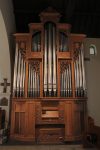Palm Sunday
The citizens of the nation’s capital moved from triumph to tragedy 160 years ago. On April 4, 1865, the Civil War was ending and news of the fall of Richmond was spreading through Washington, D.C. Public buildings throughout the city were illuminated in celebration.
“It was indeed glorious,” said Benjamin Brown French, the commissioner of public buildings. “All Washington was in the streets.” French went to his Bible and turned to Psalm 118. He had the 23rd verse printed on a cloth, in enormous letters, and then raised it on the Capitol building: “This is the Lord’s doing; it is marvelous in our eyes.”
Celebrations continued through April 9, Palm Sunday, when Confederate General Robert E. Lee surrendered at Appomattox, Va. In Washington, guns were fired in salute, to commemorate the day. The euphoria of the Union victory was felt throughout the Holy Week that followed, with crowds taking to the streets.
But tragedy struck on April 14, Good Friday, when President Lincoln was shot while attending a play at Ford’s Theatre. The president was taken to a house across the street, where he lay dying. Sen. Charles Sumner of Massachusetts appeared at his bedside and kept vigil through the night. He was one of the few people present when Lincoln died on the morning of April 15, and later wrote a eulogy for him.
From triumph to tragedy in just one week. One day, citizens of Washington were celebrating in the streets. A short time later, they were lining up for a massive funeral procession for the president.
Like the residents of Jerusalem, they moved quickly from palms to passion.
On the first Palm Sunday, Jesus and his disciples were on the road to Jerusalem, the nation’s capital. He sent two disciples into a village ahead of them, telling them that they would find a colt that had never been ridden. This was not a war horse like Traveller, the horse that General Lee rode into many battles. Nor was it like Cincinnati, the favorite of Union General Ulysses S. Grant. Grant called Cincinnati “the finest horse” that he had ever seen, and he rode the horse to Appomattox to receive Lee’s surrender.
The colt that Jesus wanted was a symbol of peace, not war. “Untie it,” said Jesus, “and bring it here” (Luke 19:30).
The disciples brought the colt to Jesus, threw their cloaks on it to create a kind of saddle, and set Jesus on it. As Jesus was moving along the path, down from the Mount of Olives, the whole multitude began to praise God joyfully for all the deeds of power that they had seen. They shouted, “Blessed is the king who comes in the name of the Lord! Peace in heaven, and glory in the highest heaven!” (v. 38).
They were quoting Psalm 118, the very same psalm that had been put on the United States Capitol at the end of the Civil War. “Blessed is the one who comes in the name of the LORD” (v. 26), said the multitude in Jerusalem. “This is the LORD’s doing; it is marvelous in our eyes” (v. 23), said the banner on the Capitol.
In both capital cities, the mood on Palm Sunday was one of triumph. In ancient Israel, palms were signs of victory and goodness, similar to the illumination of public buildings in Washington in April 1865.
But triumph gave way to tragedy in Washington, and palms were replaced by passion in the city of Jerusalem. The word passion means “suffering,” and the passion of Jesus Christ began very soon after his triumphal entry on a colt.
After entering Jerusalem, he wept over the city. Then he cleansed the temple. His authority was questioned by the chief priests, scribes and elders of the people. Jesus predicted the destruction of the temple and spoke of signs and persecutions. Then the plot to kill Jesus unfolded, culminating in his betrayal, arrest and crucifixion.
Holy Week in Jerusalem moved quickly from palms to passion, from celebration to suffering.
While some might find this to be a surprising turn of events, there are hints of the passion to be found in the events of Palm Sunday. When Jesus arrives on a colt instead of a war horse, you know that he is a very different kind of king. “Jesus does not come to conquer the city,” writes theologian Ian Paul; “he comes to be conquered.” He achieves his goals not by military strength, but by sacrifice. In this great reversal, Jesus comes “to win an even more profound victory.”
The victory of Jesus is not the triumph we would expect. Instead of attacking the hated Roman Empire, he enters Jerusalem with a message of peace. Instead of begging God to spare him, he prays, “not my will but yours be done” (Luke 22:42). When the crowd on Palm Sunday shouts, “Peace in heaven, and glory in the highest heaven!” (19:38), they are not yet aware how this peace will be won. They do not yet grasp that Jesus will be making peace between people and God through his death on the cross.
“This is why he brings praise and joy,” says Ian Paul, “because his death and resurrection have dealt with the things which separate us from God and from one another. This is the power he offers: power to know forgiveness and peace of mind.”
The reason we feel joy on Palm Sunday is not because Jesus is a hero of Jerusalem. No, it is because he is our Lord and Savior, in every time and place. His death breaks down the barrier that separates us from God and one another. His sacrifice unleashes a power that provides us with forgiveness and peace of mind.
Abraham Lincoln has long been known as the Great Emancipator. After all, he issued the Emancipation Proclamation and freed the slaves. In his eulogy to Lincoln, Sen. Sumner said, “Mourn not the dead, but rejoice in his life and example. … Rejoice that through him Emancipation was proclaimed.”
Sumner’s words are appropriate for Jesus as well as we move from palms to passion. We can rejoice that through Jesus “Emancipation was proclaimed” — emancipation from sin and death. We can rejoice in “his life and example” — a life of grace and peace, and an example of service and sacrifice.
This Holy Week presents us with a challenge. We can stand with the multitude and shout, “Blessed is the king who comes in the name of the Lord! Peace in heaven, and glory in the highest heaven!” (Luke 19:38). Or we can join the Pharisees in the crowd who say to him, “Teacher, order your disciples to stop” (v. 39). If we stand with the multitude, we are saying that we believe in Christ’s message of peace and his surprising victory over sin and death. If we join the Pharisees, we ‘e saying that Jesus is not worthy of celebration.
Where do you stand? Are you willing to accept the connection between palms and passion? Between triumph and tragedy? Jesus is aware that some in the crowd will stop their praises, but he knows equally well that God’s will must be done. “I tell you,” he says to the Pharisees, “if these were silent, the stones would shout out” (v. 40).
On this Palm Sunday, let’s stand with the multitude and begin the journey from the triumph of Jesus’ entry to his passion and death on Good Friday. We will remember and mourn his death, but also rejoice in his life, his example, and his work of emancipation.
The Christian life accepts both palms and passion, triumph and tragedy. “This is the LORD’s doing,” says Psalm 118; “and it is marvelous in our eyes” (v. 23).
 St. Andrew’s Episcopal Church was established in Tampa in 1871. Its first service was held in the hospital building at Fort Brooke. A wooden church was erected in 1883 on the city block bounded by Marion, Twiggs, Morgan, and Madison.
St. Andrew’s Episcopal Church was established in Tampa in 1871. Its first service was held in the hospital building at Fort Brooke. A wooden church was erected in 1883 on the city block bounded by Marion, Twiggs, Morgan, and Madison. This history of the Windows of Saint Andrew’s is based upon research by the late Laban G. Lively. Additional information has been added by Nancy Turner. It is reconstructed for presentation on the WWW by Joe Daurril. Photos taken by Chris Cobb.
This history of the Windows of Saint Andrew’s is based upon research by the late Laban G. Lively. Additional information has been added by Nancy Turner. It is reconstructed for presentation on the WWW by Joe Daurril. Photos taken by Chris Cobb. The organ at St. Andrew’s Episcopal Church, Tampa, Florida, was designed and built by C. B. Fisk, Inc., of Gloucester, Massachusetts.
The organ at St. Andrew’s Episcopal Church, Tampa, Florida, was designed and built by C. B. Fisk, Inc., of Gloucester, Massachusetts. Ministry at St. Andrew’s is an integral part of our parish life and our community.
Ministry at St. Andrew’s is an integral part of our parish life and our community. St. Andrew's seeks to ensure that we are meeting the spiritual and religious education needs of all our members.
St. Andrew's seeks to ensure that we are meeting the spiritual and religious education needs of all our members.

 St. Andrew’s Episcopal Church was established in Tampa in 1871. Its first service was held in the hospital building at Fort Brooke. A wooden church was erected in 1883 on the city block bounded by Marion, Twiggs, Morgan, and Madison.
St. Andrew’s Episcopal Church was established in Tampa in 1871. Its first service was held in the hospital building at Fort Brooke. A wooden church was erected in 1883 on the city block bounded by Marion, Twiggs, Morgan, and Madison. This history of the Windows of Saint Andrew’s is based upon research by the late Laban G. Lively. Additional information has been added by Nancy Turner. It is reconstructed for presentation on the WWW by Joe Daurril. Photos taken by Chris Cobb.
This history of the Windows of Saint Andrew’s is based upon research by the late Laban G. Lively. Additional information has been added by Nancy Turner. It is reconstructed for presentation on the WWW by Joe Daurril. Photos taken by Chris Cobb.
 The organ at St. Andrew’s Episcopal Church, Tampa, Florida, was designed and built by C. B. Fisk, Inc., of Gloucester, Massachusetts.
The organ at St. Andrew’s Episcopal Church, Tampa, Florida, was designed and built by C. B. Fisk, Inc., of Gloucester, Massachusetts. Ministry at St. Andrew’s is an integral part of our parish life and our community.
Ministry at St. Andrew’s is an integral part of our parish life and our community. St. Andrew's seeks to ensure that we are meeting the spiritual and religious education needs of all our members.
St. Andrew's seeks to ensure that we are meeting the spiritual and religious education needs of all our members.